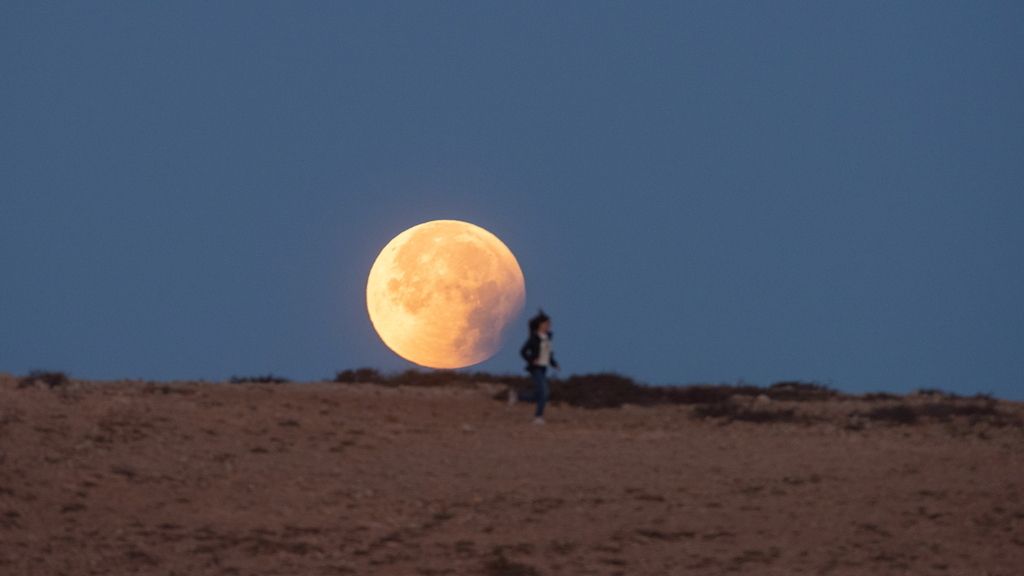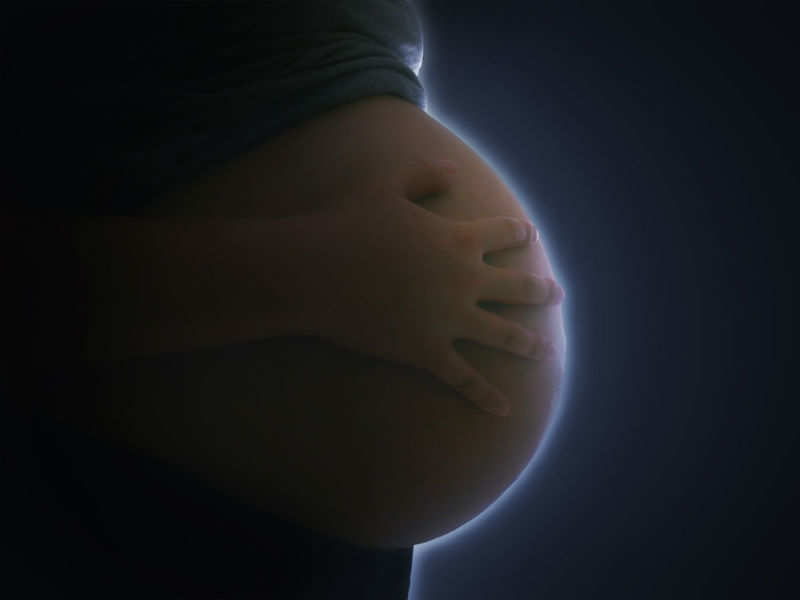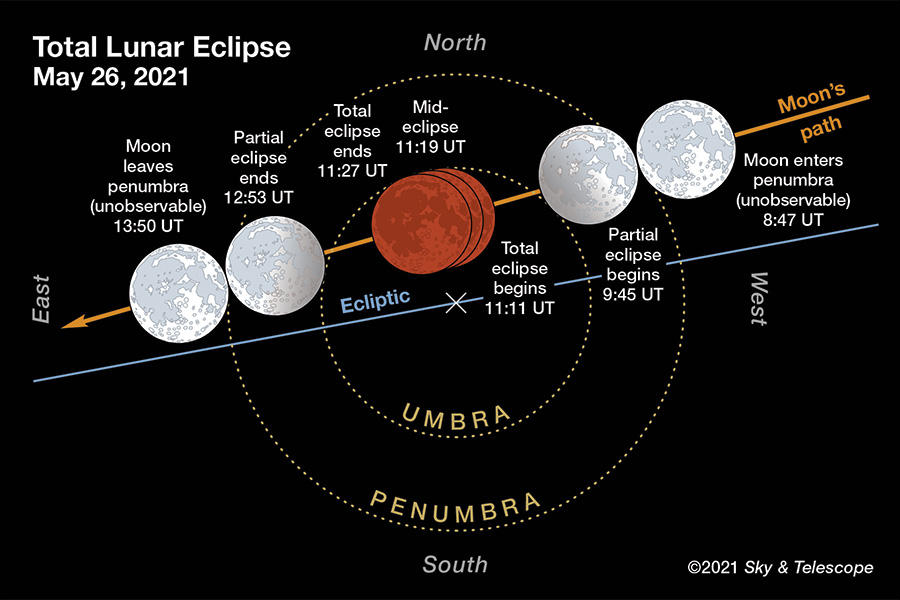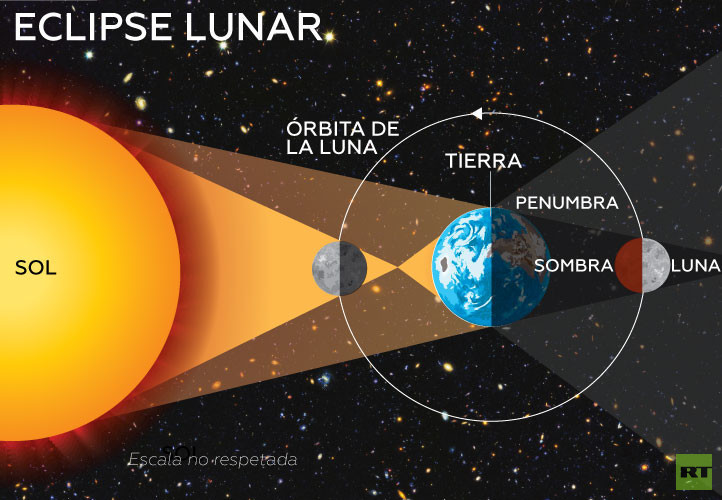El embarazo siempre ha sido relacionado con las fases lunares.
8 noviembre, 2022
10:45
Cristina Gómez
Hay fenómenos meteorológicos que todavía están rodeados de misticismo y espiritualidad. Un ejemplo son los eclipses, que por su belleza y fugacidad nos atrapan y desatan antiguas creencias que la ciencia rebatió hace tiempo. Si eso se une al embarazo y la fertilidad, otros dos sucesos que siempre se han relacionado con la naturaleza, conseguimos un cóctel repleto de falsas creencias y supersticiones.
Esta noche tendrá lugar la penúltima luna llena de 2022, uno de los eventos astronómicos más esperados de este mes de noviembre. Se trata del último eclipse lunar total que podrá observarse desde la Tierra en casi tres años, aunque solo podrá contemplarse en el este de Asia, Australia, el Pacífico y América del Norte.
Pero ¿cómo puede afectar este acontecimiento al embarazo? Según las creencias antiguas, de las cuales cabe destacar que no hay ningún tipo de evidencia científica, las embarazadas no pueden observar el eclipse, ya que podría provocar lo siguiente:
Para evitar todos estos supuestos efectos del eclipse, incluso se recomienda a las embarazadas que se pongan una cinta o listón rojo alrededor de su vientre, que lleven consigo un objeto de metal y hagan mucho ruido para ahuyentar lo negativo.
Y estos no son los únicos mitos. También se dice, por ejemplo, que cuando hay eclipse se adelgaza, o que no es bueno cocinar durante el eclipse porque las radiaciones del sol envenenan la comida.
Por supuesto, todas estas creencias vienen de hace siglos, cuando no se entendía por qué se producían los eclipses. Además, lo que sí es cierto es que los eclipses provocan algunos cambios ambientales en la Tierra. Por ejemplo, puede haber bajada de temperaturas, cambios en la dirección de los vientos o en el comportamiento de algunos animales, y también variaciones en el campo gravitacional terrestre. No obstante, nada de esto influye en la salud de las personas ni, por supuesto, en desarrollo correcto del embarazo.
Más allá de los eclipses, el embarazo siempre ha sido relacionado con las fases lunares. Así, la fase lunar en la que se produce la concepción supuestamente influye en el sexo del bebé.
Otro mito muy extendido es que se producen más partos espontáneos con luna llena. En este caso, la ciencia sí que ha demostrado que es mentira. Hay numerosos estudios que han analizado el número de partos espontáneos en las distintas fases lunares y las diferencias no son significativas.
En este caso, la ciencia sí que ha demostrado que es mentira. Hay numerosos estudios que han analizado el número de partos espontáneos en las distintas fases lunares y las diferencias no son significativas.
Un ejemplo de ello es el estudio publicado en 2005 por el Mountain Area Health Education Center de Carolina del Norte. Los investigadores analizaron 600.000 nacimientos en 62 ciclos lunares entre 1997 y 2001 y las conclusiones, publicadas en The American Jorunal of Obstetrics and Gynecology, no encontraban diferencias significativas en las fases de la luna.
Dejando a un lado las supersticiones, lo importante es que todos aquellos que quieran puedan disfrutar esta noche del eclipse lunar, que ocurre cada mucho tiempo.
Astrología
Astronomía
Eclipses
Embarazo
Regístrate gratis y recibe cada mañana las noticias en tu correo
Cómo reparar el pelo dañado (sin importar cual sea tu presupuesto)
Anterior
“Golden Nail Congress”: así será el encuentro de los expertos en manicura
Siguiente
¿Es cierto que el eclipse de Luna afecta a las mujeres embarazadas? Esto es lo que la ciencia revela sobre el mito viral | Sociedad | La Revista | El Universo
SociedadEclipses
Las abuelas recomiendan a la mujer embarazada poner una cinta o listón rojo alrededor de su vientre. Además, cargar algún objeto de metal.
Además, cargar algún objeto de metal.
En su totalidad, la naturaleza abarca un halo de misterio y encanto. Foto: m-gucci
Publicidad
El eclipse de Luna será al anochecer de este domingo 15 de mayo y permanecerá hasta la madrugada del lunes 16. Como muchos fenómenos astronómicos, este evento levanta comentarios, creencias y mitos que se hacen virales en las redes sociales.
(En vivo) Eclipse de Luna de Sangre se puede observar sobre el cielo de Guayaquil
Uno de los que más se ha difundido durante décadas es que el eclipse de Luna afecta a las mujeres embarazadas. Sobre todo, las madres y abuelas aseguran que una embarazada jamás deberá mirar un eclipse. Algunos mitos sobre este tema son, según Milenio:

Hasta los momentos no existen pruebas científicas que demuestren la malignidad de los eclipses de Luna sobre las embarazadas. Foto: Pexels.
En su totalidad, la naturaleza abarca un halo de misterio y encanto. Los astros, las fases lunares, los eclipses y muchos fenómenos se relacionan a aspectos de la vida humana, asegura Eres Mamá.
Publicidad
Sin embargo, hasta los momentos no existen pruebas científicas que demuestren la malignidad de los eclipses de Luna sobre las embarazadas. Solo se trata de mitos y leyendas de antaño, cuando los eventos astrológicos se consideraban mágicos y misteriosos.
Lo que sí afecta a la mujer embarazada es el estrés y la ansiedad que producen estas creencias. Foto: FtLaudGirl
Al parecer estas creencias también se avalan en los supuestos efectos de la “radiación dañina” del Sol durante los eclipses. Pero todos estos mitos ya la ciencia los refutó y nada pasará mañana mientras la Luna se tiñe de Sangre.
Pero todos estos mitos ya la ciencia los refutó y nada pasará mañana mientras la Luna se tiñe de Sangre.
Lo que sí afecta a la mujer embarazada es el estrés y la ansiedad que producen estas creencias, sobre todo porque durante la gestación ellas están más sensibles de lo habitual y son más vulnerables a cualquier amenaza psicológica.
(I)
Redacción
eluniversocom
Publicidad
EclipsesAstrosEmbarazo
Publicidad
¿Tienes alguna sugerencia de tema, comentario o encontraste un error en esta nota?
FútbolMundial Qatar 2022
El equipo dirigido por Tire tendrá a todos sus exponentes para su primer encuentro
Por: Jorge Barraza
Publicidad
The lunar eclipse is an impressive sight!
A lunar eclipse can be observed where the Moon is above the horizon at the time of the phenomenon. The points of intersection of the Moon’s orbit with the plane of the ecliptic are called the nodes of the lunar orbit, and when they are close to the Sun-Earth-Moon line, a lunar or solar eclipse occurs. The rest of the time, the Moon passes either below or above the Earth’s shadow (or the Sun). Due to the discrepancy between the planes of the lunar and earth orbits, not every lunar eclipse is a total shadow. The maximum number of lunar eclipses per year is 4 (for example, this will happen in 2020 and 2038), the minimum number of lunar eclipses is two per year. Eclipses repeat in the same order every 6585⅓ days (or 18 years 11 days and ~8h).
The points of intersection of the Moon’s orbit with the plane of the ecliptic are called the nodes of the lunar orbit, and when they are close to the Sun-Earth-Moon line, a lunar or solar eclipse occurs. The rest of the time, the Moon passes either below or above the Earth’s shadow (or the Sun). Due to the discrepancy between the planes of the lunar and earth orbits, not every lunar eclipse is a total shadow. The maximum number of lunar eclipses per year is 4 (for example, this will happen in 2020 and 2038), the minimum number of lunar eclipses is two per year. Eclipses repeat in the same order every 6585⅓ days (or 18 years 11 days and ~8h).
On January 31, almost all residents of Russia (except for the western regions) will have the opportunity to observe a total lunar eclipse. All phases, from beginning to end, will be visible in Novosibirsk and to the east of it. At the 73rd parallel and to the north, the Moon on January 31 is visible around the clock, so the entire course of the eclipse in these latitudes can be observed regardless of location.
It should be noted that the moments of the onset of the phases of a lunar eclipse are the same for the entire hemisphere of the Earth from which this interesting phenomenon is observed, so the observer at one point or another only needs to take into account the difference in time zones.
Fig.1 Highlights of the eclipse. Universal Time (UTC)
During the eclipse, the Moon is in the constellation Cancer. The total phase of the eclipse will begin at 19:52 and end at 21:08 (UTC). The maximum shadow phase of the eclipse will occur at 20:30, the duration of the total eclipse will be 1 hour 16 minutes. The total duration is 3 hours 24 minutes.
The eclipse will occur near the perigee of the lunar orbit, the angular diameter of the moon will be 33’10” (the average diameter of the Moon is about 31’05”), the angular diameter of the earth’s shadow is 90’48”.
|
Moment of the phenomenon |
Time |
Phase |
|
Beginning of partial eclipse |
18 hours 48 minutes |
0. |
|
Beginning of total eclipse |
19 hours 52 minutes |
1.00 |
|
Moment of largest phase |
20 hours 30 minutes |
1.32 |
|
End of total eclipse |
21 hours 08 minutes |
1.00 |
|
End of private eclipse |
22 hours 12 minutes |
0.00 |
The penumbral eclipse will begin at 17:49. At this moment, the left lunar edge (when the Moon moves among the stars from right to left) will touch the penumbra of the Earth. A penumbral eclipse is hardly visible to the naked eye, especially at small phases, but as you approach the edge of the earth’s shadow, the darkening becomes more and more noticeable. The beginning of the partial phase of the eclipse will take place at 18 hours 48 minutes, and from that moment the Moon will begin to sink into the shadow of the Earth. The moment when the night luminary is completely immersed in the earth’s shadow will come at 19hours 52 minutes. Depending on the state of the atmosphere and some other factors, the darkening of the lunar disk during a total eclipse may vary. It can be very dark, when the Moon is almost invisible in the night sky, or it can be bright, when the Moon is clearly visible even at full phase. The color can be dark maroon, and maybe bright red. The degree of darkening during total lunar eclipses is determined by the five-point Danjon scale.
The moment when the night luminary is completely immersed in the earth’s shadow will come at 19hours 52 minutes. Depending on the state of the atmosphere and some other factors, the darkening of the lunar disk during a total eclipse may vary. It can be very dark, when the Moon is almost invisible in the night sky, or it can be bright, when the Moon is clearly visible even at full phase. The color can be dark maroon, and maybe bright red. The degree of darkening during total lunar eclipses is determined by the five-point Danjon scale.
Fig.2 Danjon scale for estimating the brightness of the Moon’s disk
At 21:08, the night luminary will begin to leave the shadow of the Earth. Gradually becoming brighter, the eclipsed lunar disk will take on phases similar to the monthly moon, only with the difference that they will change much faster. At 22:12, the Moon will completely leave the earth’s shadow, but the penumbral eclipse will continue until 23:10, after which the night star will shine again in full force.
It is worth mentioning the next lunar eclipse, which will occur along with the opposition of Mars on July 27-28, 2018.
On the night of July 27-28, the “red” Moon and the red planet Mars will be visible above the southern horizon!
The fourth eclipse of 2018 will be a total lunar eclipse. It will take place on July 27th. Its maximum shadow phase will be 1.61 when the Moon passes almost through the center of the Earth’s shadow. This eclipse will be observed in different phases in most of the territory of Russia and the CIS countries (with the exception of the northern and eastern regions of the country), and its maximum phase will reach 1.614. The duration of the shadow eclipse will be 1 hour 43 minutes, which is the maximum value in the current century. The total duration of the shadow eclipse will be about 4 hours.
For Mars, 2018 is a favorable time for observations of , because On July 27, the planet will reach great opposition (in the constellation Capricorn) with a maximum apparent diameter of over 24 arcseconds. The distance to the planet will be 0.4 AU. (1 AU – about 150 million km). Such an event happens once in 15, 17 years. During the great oppositions, Mars becomes brighter than Jupiter and is second only to Venus among the planets in brilliance. It will stand out in the sky with a bright orange color. This great opposition will be marked by a total lunar eclipse on the same day! In northern latitudes, Mars will be low on the southern horizon.
The distance to the planet will be 0.4 AU. (1 AU – about 150 million km). Such an event happens once in 15, 17 years. During the great oppositions, Mars becomes brighter than Jupiter and is second only to Venus among the planets in brilliance. It will stand out in the sky with a bright orange color. This great opposition will be marked by a total lunar eclipse on the same day! In northern latitudes, Mars will be low on the southern horizon.
Material prepared by Victoria Damm, UC Planetarium
school astronomical calendar for the 2017/2018 academic year. Issue 68;
astronomical calendar for 2018;
Stellarium program.

A total eclipse (a phenomenon in which the Moon completely covers the Sun, the sky will darken and several bright stars and planets will appear on it) will not be observed anywhere on Earth this time. The lunar shadow will pass by the Earth – above the north pole, but the lunar penumbra will cover a significant part of Eurasia and even touch the northeast of the African continent.
Some terminology
A solar eclipse in which the Moon completely covers the Sun is called a total , or – total phase solar eclipse.
The Moon does not always have an angular size greater than that of the Sun. In some cases, the Moon is not able to completely cover the daytime star precisely because of its smaller apparent size. And then happens an annular solar eclipse , which is often erroneously called “annular” – this is wrong. Correct name: “ Annular Solar Eclipse “.
A total or annular solar eclipse is preceded by partial phases , and sometimes the eclipse does without total or annular phases at all – like this time.
Then astronomers talk about the solar eclipse of . People unfamiliar with astronomical terminology often mistakenly call such an eclipse “partial” – this is incorrect. Correct name: “ Partial solar eclipse “.
Mobilization may be partial. And the eclipse is quotient .
The maximum phase of the eclipse in Moscow is 71%. 13 hours 38 minutes
If a total solar eclipse is visible in those regions of the Earth where the lunar shadow falls, then a partial solar eclipse owes its visibility to the lunar penumbra. A clear diagram showing the relative position of the Sun, Earth and Moon (not to scale, of course, but more on that later) during a partial solar eclipse, as well as illustrating what the Moon’s shadow, lunar penumbra is, is drawn below.
The diagram clearly shows that, since the Sun is larger than the Moon, the Moon casts a converging shadow cone into space. In some situations, this cone converges even before reaching the Earth’s surface, and then the eclipse is annular. But in this case, the cone of the lunar shadow does pass by – above the north pole of the Earth. The southern hemisphere will not get an eclipse at all this time. Unlike the lunar shadow, the lunar penumbra is a diverging cone that (theoretically) does not end anywhere in space – it is infinite in the direction from the Sun. But its intensity decreases with distance from the Moon.
But in this case, the cone of the lunar shadow does pass by – above the north pole of the Earth. The southern hemisphere will not get an eclipse at all this time. Unlike the lunar shadow, the lunar penumbra is a diverging cone that (theoretically) does not end anywhere in space – it is infinite in the direction from the Sun. But its intensity decreases with distance from the Moon.
There on the Earth, where the lunar penumbra falls, one can see how the Sun was damaged – something dark, opaque covers some part of the daylight. It is not difficult to guess that this is the Moon. People guessed this many thousands of years ago. But humanity is unevenly developed. Who to this day does not understand what is the matter.
On this map, the area of visibility of the eclipse is surrounded by a dark green line. The raspberry line indicates the locations where the maximum phase will occur at sunset. Inside the curved green “eight”, the Sun will set below the horizon before the end of the eclipse (that is, along with the Moon). The green star marks the place on Earth where the largest phase of the eclipse will be observed.
The raspberry line indicates the locations where the maximum phase will occur at sunset. Inside the curved green “eight”, the Sun will set below the horizon before the end of the eclipse (that is, along with the Moon). The green star marks the place on Earth where the largest phase of the eclipse will be observed.
There it will happen at the time of sunset, and the nearest cities to this point “X” will be Nizhnevartovsk and Surgut.
The dashed green line shows the locations on Earth where the maximum eclipse phase will reach half of the maximum possible on the planet.
The eclipse will be clearly visible throughout Europe (with the exception of Spain – here it is visible only in the east of the country, and Portugal – it is invisible here at all), in Russia to the Urals, in eastern Kazakhstan, in the Near and Middle East, in Egypt, Libya, Northern Sudan , in Ethiopia. An extremely unsatisfactory eclipse will be visible on the western coast of Greenland, but it is unlikely that any of my readers are very interested in the latter circumstance.
An extremely unsatisfactory eclipse will be visible on the western coast of Greenland, but it is unlikely that any of my readers are very interested in the latter circumstance.
For residents of Russia there is a very informative table prepared by the team of the astronomical site Astroverts, which clearly shows in which cities what will be the maximum phase of the eclipse, and when it occurs.
For residents of other countries there are convenient tables with a list of cities on the page about the eclipse in the Russian Wikipedia.
To clarify the details, the Stellarium program will help you, in which you can see the course of the upcoming eclipse for any city on Earth. The program is freely distributed and free. This is the program I use to create illustrations for my articles. Here some pictures are also obtained with its help.
Important!
When observing solar eclipses of any kind – whether it is partial, total or annular – you must be extremely careful and use a special protective filter.
In no case should you look at the Sun through binoculars, a telescope or a telescope without a special solar filter. No other filters are suitable for observations, except for special high-density solar filters. Photographers often use neutral density filters in their practice to shoot landscapes on a bright sunny day – this is not suitable for observing solar eclipses.
Where can I find a suitable filter?
In special stores that sell telescopes and accessories for them – there all the sellers know everything very well. Look for them on the Internet. There are quite a few of them.
Actually there is a life hack
For observation just with the eye (not through a telescope!) an old lighted photographic film, a CD without paint, a magnetic film from an old floppy disk, or an x-ray image showing bones and joints may be suitable. But it’s all good just to look at the Sun without optics.
Take care of your eyes!
These days the planet Venus is in superior conjunction with the Sun. This means that, to a terrestrial observer, Venus is almost exactly behind the Sun – with a slight deviation – only one degree to the north. If the eclipse were total, Venus could be seen with the eye during the eclipse. But during a partial eclipse, Venus is not visible. Although, Stellarium still shows it.
This means that, to a terrestrial observer, Venus is almost exactly behind the Sun – with a slight deviation – only one degree to the north. If the eclipse were total, Venus could be seen with the eye during the eclipse. But during a partial eclipse, Venus is not visible. Although, Stellarium still shows it.
Experienced amateur astronomers (and professional astronomers too, but they are unlikely to need it for some reason) can see Venus with special optics at such a small angular distance from the daylight. But this is a special challenge, and without special tools and experience, you should not get involved in it.
Also from Astroverts:
Let’s consider what we can do if we still want to draw the Earth, the Moon, the Sun and the distances between them on a single scale.
Let’s choose a conditional size of 1 millimeter for the Earth. This is small, but you will soon understand why you should not choose a larger size.
Then the Moon will be a poppy seed, 30 millimeters away from the blue bead — the Earth. It seems to be nothing to worry about.
But then the Sun, a circle with a diameter of 11 centimeters, will be 11 meters 80 centimeters away from the Earth-Moon system.
Yes, of course, there is – in the toilet – they still stocked up from the pandemic. But drawing eclipse diagrams on toilet paper is so-so.
And what if we sacrifice the scale reliability of the distance to the Sun, and fit the Sun and the Earth-Moon system at least within the bounds of a piece of drawing paper?
Then the cone of the lunar shadow will converge much faster, and it will not reach the Earth, and the divergent cone of the lunar penumbra will always cover our entire planet, from which it will be possible to draw the erroneous conclusion that partial solar eclipses occur every new moon.